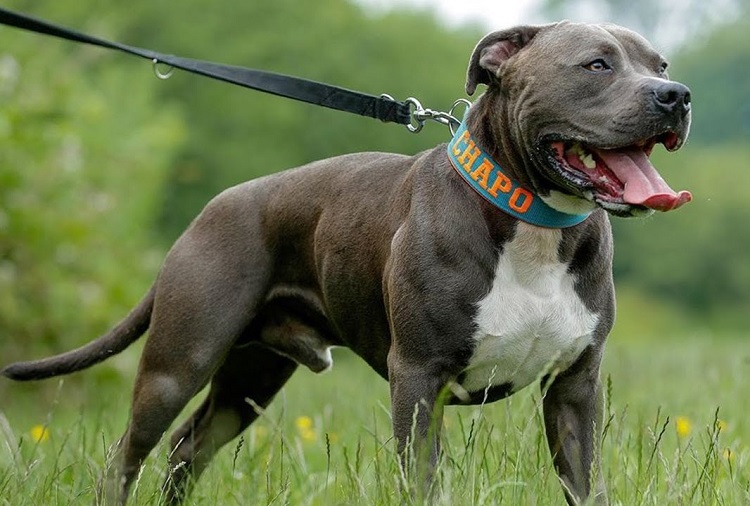The Blue Nose Pitbull Terrier has many misconceptions surrounding it, as most bully breeds do. However, this spectacular dog deserves its own spotlight, so we’re deep diving into this canine mixture of power, beauty, and heart.
This type of dog is just that – a type. It’s a variation of a purebred American Pitbull Terrier, an American Staffordshire Terrier, or a mixture of both.
According to the American Kennel Club (AKC),a regular pit bull isn’t a breed at all, and the Blue-Nose Pitbull is not a separate breed that stands alone.They carry a recessive gene that triggers decreased melanin production, giving their nose a blue-gray coloring, hence, its name.
Additionally, the name “Pitbull” itself often splits people into two camps. You love ’em, or you fear ’em. So let’s get things straight and talk about what are facts and what is fiction about Blue-Nosed Pit bulls.
General Information on Pitbull Terrier Breeds
Staffys, AmStaff, Pitties, and Bullies are a few of the nicknames people use to describe a dog with a broad chest, cropped ears, and stout bodies. A “Pitbull” is a nickname, too. It’s a type of dog, just like a setter, poodle, or hound. For example, there are English and Irish setters; Basset and bluetick hounds, among others; and standard, miniature, and toy poodles.
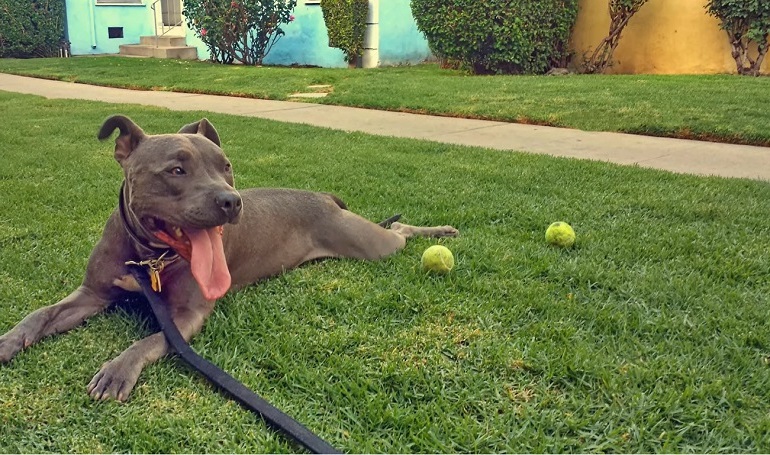
Here are the breeds within the Pitbull Terrier family:
- American Staffordshire Terrier (AST)
- Staffordshire Bull Terrier (SBT)
- American Pitbull Terrier (APBT)
The American Bulldog is not considered a Pitbull Terrier, although that information can be found in many sources. It is related to the English Bulldog.
The American Pit bull Terrier is a dog breed but not one recognized by the AKC. However, it is recognized by the United Kennel Club (UKC in America) and the American Dog Breeders Association (ADBA), the largest registration office for the American Pit Bull Terrier.
The term “Pitbull” isn’t an umbrella term for all bully breeds. Cane Corsos, mastiffs, boxers, Boston terriers, Rottweilers, and American bulldogs, as well as many others, are all considered to be bully breeds.
To further muddy the waters, there are bull-type dogs, terriers that aren’t bully dogs, and (historically) fighting dogs like Akitas that also aren’t pit bulls.
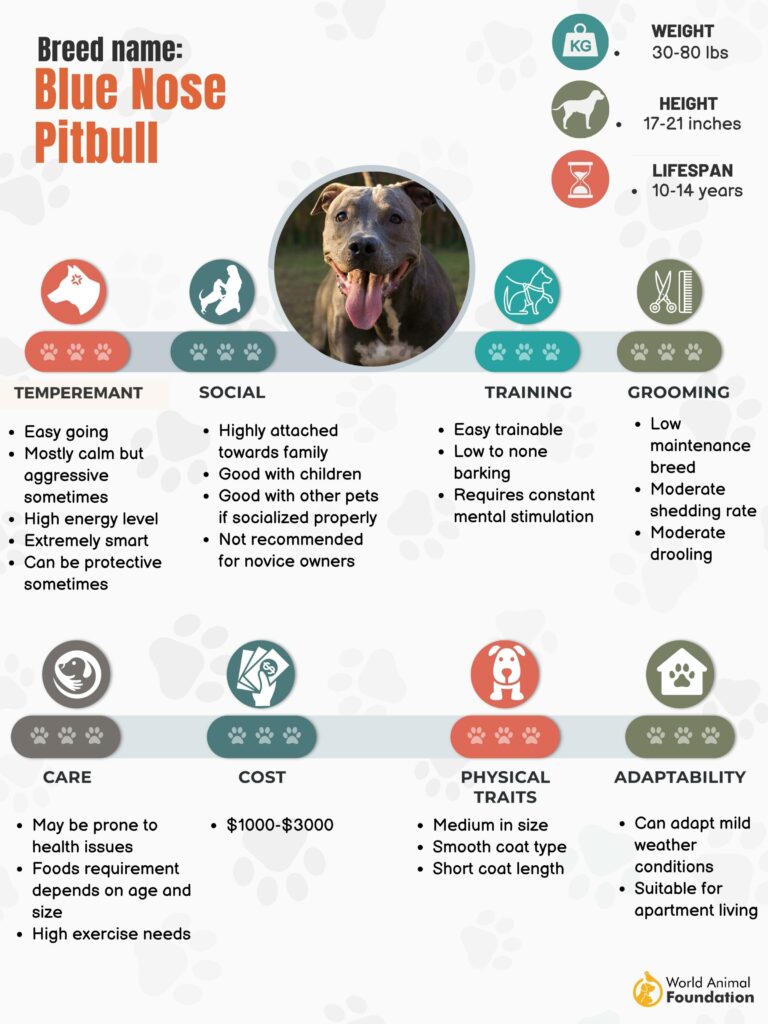
About the Breed
What the previous plethora of information tells us is that the Blue Nose Pitbull Terrier is a variation of a dog breed and is generally misunderstood. In reality, these beautiful, loyal dogs are gentle in nature and lovers at heart.
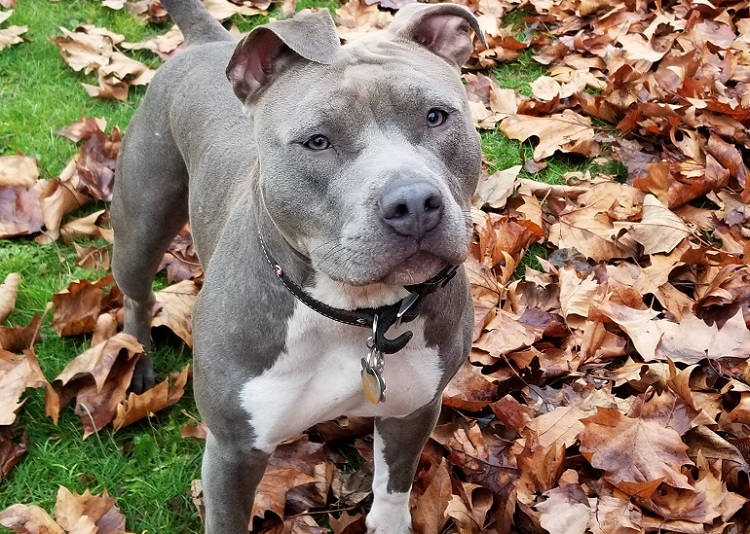
Their ability to translate their feelings to their faces is a fact well-known to their owners. With expressive faces, they often look as if they’re smiling when they’re panting.
Those who are well-socialized at a young age are great with children and as loyal to their families as dogs come. They love people and get plenty of attention.
Just be sure to supervise when these family pets, or any dogs, are around very young kids. But don’t be surprised that Blue-Nose Pitbulls are incredible with children and have even been called “nanny dogs“.
Although some might think they are rare, that would be wrong. Disreputable breeders like to advertise them this way, but they also actually created/bred them to make a buck. Just know there are plenty of Blue Nose Pitbulls, and don’t get pulled in by a “You can only get one here” or “Extremely rare” advertisement. Always go with reputable breeders.
History of the Blue Nose Pitbull
The Blue Noses’ history is more recent, and just as with other pit bull terriers, they have quite a storied past. The Blue Nose Pitbull was bred in England – using bulldogs and terriers – in the 19th century to be used for bull and bear hunting. In America, they’ve been used to farm, hunt, protect land, have as pets, and, yes, to fight.
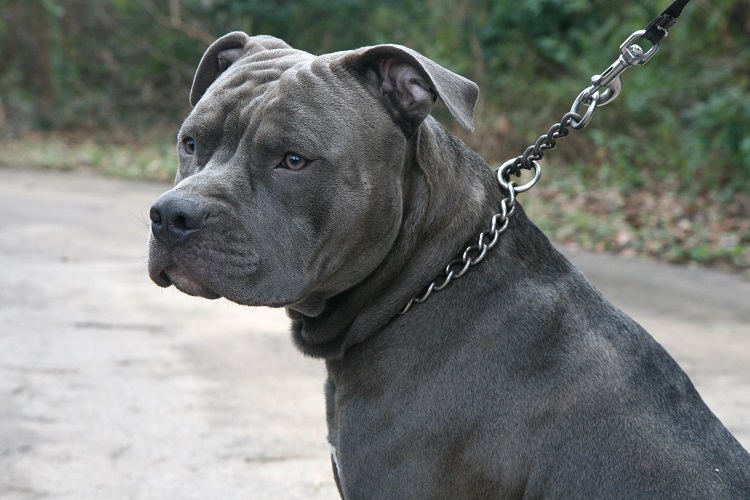
Let’s talk a bit about their ancestors since they’re so genetically close. Pitbull terriers are descendants of Old English Bulldogs in England that were also used as bull and bear-baiting dogs in the early 1800s. It was especially brutal.
Soon, bull-baiting was outlawed, and people (without a conscience) started fighting the dogs against each other. Breeders then turned to terriers to mate with the larger canines to produce a dog with better agility. They bred the terrier with the bulldog creating the Pitbull Terrier.
When immigrants came from the British Isles to America in the 1800s, their dogs accompanied them. They were initially used for herding, guarding, and hunting. Then, in the 1980s, other Pit bulls fighting their own species were unearthed and exposed to the public. Pandemonium broke loose with public scrutiny, and irrational fears developed.
Dog behavior develops largely from their environment and their genetics. If Blue Nose Pitbulls are trained to fight, they will since they are people-pleasers. Having said that, there is a myriad of reasons why a specific dog might be aggressive. According to the AKC, here are some:
- Fear
- Pain
- Age
- Sex
- Size
- Environment
These factors can contribute to a dog’s aggressive capabilities, but it depends on the dog. Not all dogs that have been abused are aggressive, and not all dogs that have only had loving homes are non-aggressive.
A dog of almost any breed can be trained to be aggressive. There’s no “aggressive” gene. Dogs are as unique as humans are and should always be treated as such.
Today, ignorance still rears its ugly head when some think all Pitbulls are dangerous, but there’s something they need to consider. These dogs now serve as military dogs, service dogs, hospice therapy dogs, and emotional support dogs (ESD or ESA).
Do some research if you still believe the fiction surrounding the stereotypical pitbull terrier. Better yet, adopt/rescue a Blue Nose Pitbull.
Owning a pitbull brings unique joy, and what better way to show off your love for your loyal companion than by sporting one of our stylish Pitbull shirts? It’s the perfect way to declare your pitbull pride to the world!
Appearance of the Blue-nose Pitbull Terrier
Following are some of the features specific to the Blue-Nose Pitbulls.
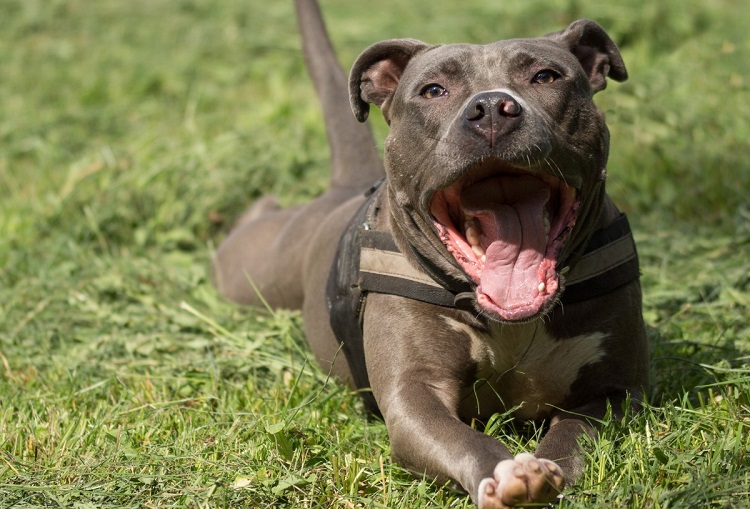
Size
The Blue Nose Pitbulls have short muzzles and broad faces. They’re quite muscular, which is one of the reasons people can be fearful of them. Like almost all other dogs, male Blue Nose Pitbulls are taller than females. Blue Nose stands between 17 and 21″ tall when grown fully, making it a medium-sized dog.
Weight
Blue Nose Pitbulls weigh around 30-80 lbs., with males weighing more than females. But these numbers are estimated, and Pitbulls are prone to variances in their final sizes.
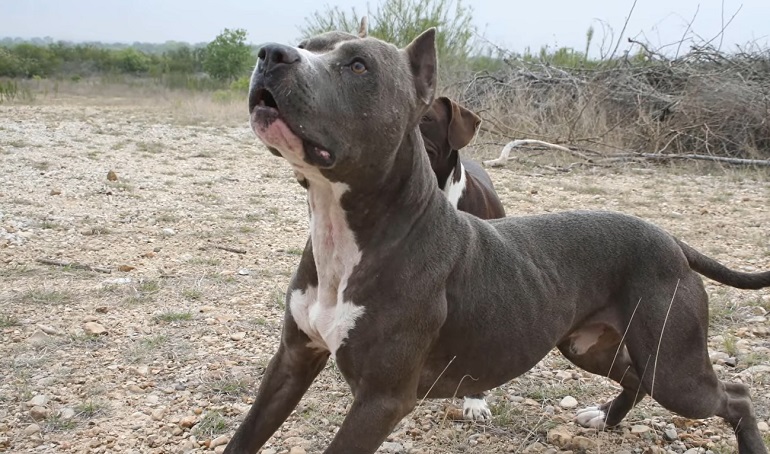
Lifespan
Blue Nose Pitbulls have a general lifespan of 10-14 years. But some have lived shorter or longer lives. According to dog care experts, there are three factors that affect the life expectancy of dog breeds; their body structure and shape, diet and health care quality, and genetic diversity.
Coat
Blue Nose Pitbulls have short coats and can have a solid color or pattern (face, chest, and paws could be white), depending on their lineage. They have a sleek look, and their coats are soft to the touch. When they’re in the sun, their true color really shines.
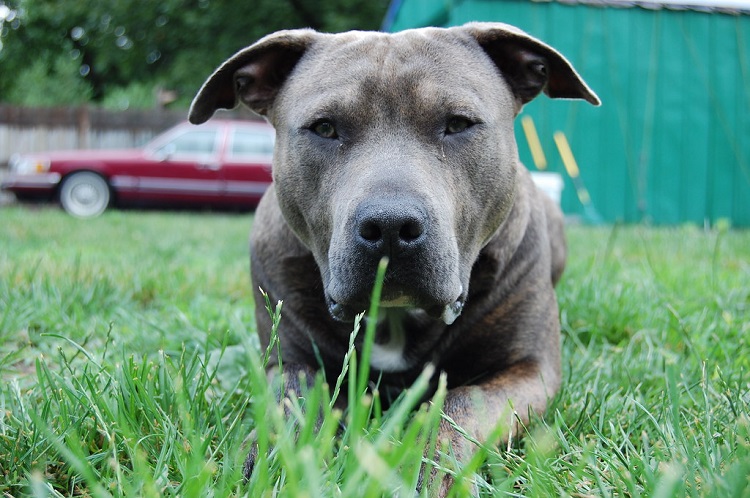
Color
Just as not all red birds are red, Blue Nose Pitbulls don’t all have blue noses. The blue-ish color is what was desired when breeding, but sometimes Mother Nature has a devilish sense of humor. Some noses are black, and some are gray. (There is also a red nose pitbull terrier, but that’s another article.)
So how did Blue Nose Pit-bulls come to have a blue-ish nose and sometimes body? When black is diluted, it will turn gray and eventually have a blue sheen.
What this means is a breeder must begin with parents that are carriers of the recessive dilution gene. Unfortunately, this often results in inbreeding. For this reason, be extremely cautious when purchasing this dog variety and use due diligence when researching breeders.
The eyes of Blue Nose Pitbulls can be brown, hazel, gray, or blue. The puppies born with blue eyes often change in color but, on rare occasions, will remain blue.
Blue Nose Pitbull Temperament and Personality
Talking about Blue Nose Pitbull’s temperament, well-adjusted Blue Nose Pits are friendly, consistently stable, and reliable. They’re great family dogs. They are loving and playful with small children and seniors alike, but make sure a professional introduces new dogs/pets to them since they can have dog aggression.
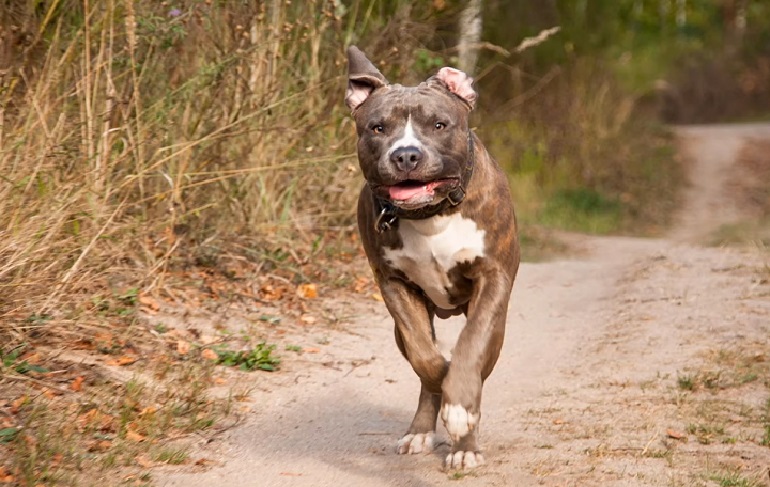
They’re also extremely intelligent and just as obedient. Training sessions should be consistent, short, and fear-free using positive reinforcement like providing dog treats. Never use force or physically discipline this, or any other, animal. Use calm, assertive commands and start when they’re young, if possible.
Adaptability
The Blue-Nosed Pitbulls can adapt to apartment living or places with lots of acreages. You just must be willing to exercise them appropriately. They adore being with you the most, so whether in a small or large area, it’s good with them.
Exercise
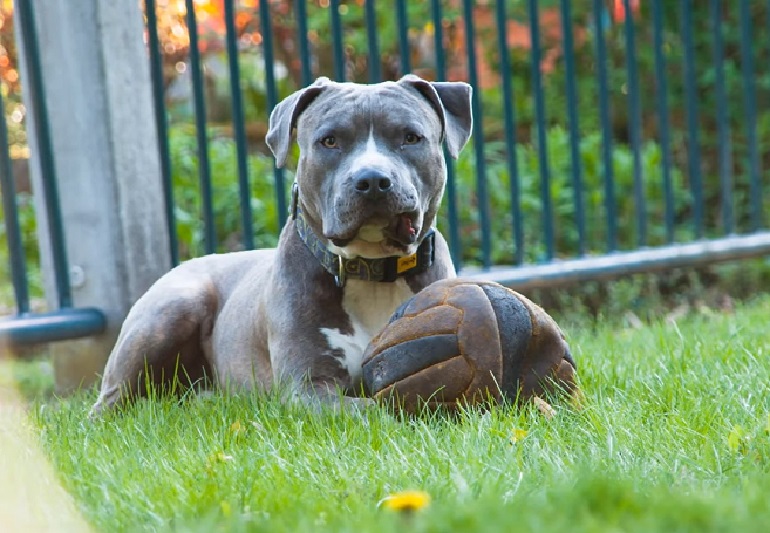
Agility sports and Blue Pit bull are like peanut butter and jelly. You can often see them using their high flexibility and high energy at agility courses.
Their muscular legs allow them to jump well, and most of them are experts at “flying through the air” for balls or frisbees. This gives them the physical exercise and mental stimulation they need.
If you’re a couch-potato kind of person (and there’s nothin’ wrong with that), this wouldn’t be the type of dog you need. A Blue Nose Pitbull needs at least 30 minutes, if strenuous, to 45 minutes, if leisurely, to exercise daily.
If they’re not properly exercised, behavioral problems may occur, like they may develop aggression or show unwanted behaviors like emotional outbursts or high levels of frustration/anxiety.
Separation Anxiety
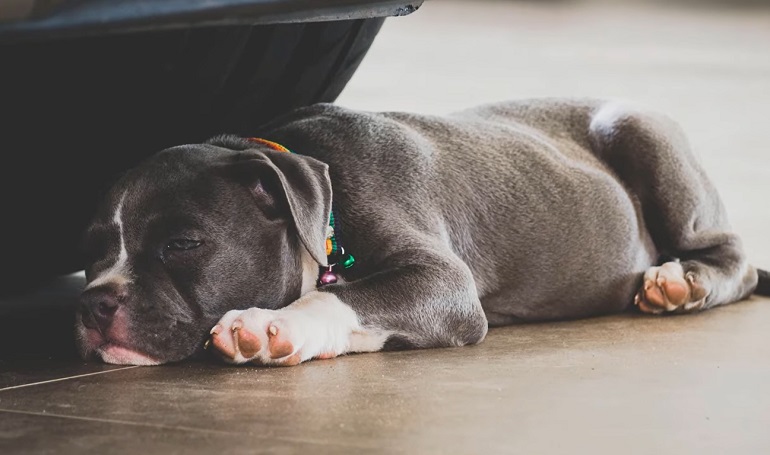
The Blue Nose Pit bull can experience separation anxiety if left alone for hours at a time or if they haven’t been exercised at the level they need to be. This pit bull wouldn’t be the best dog for people with vocations that keep them away from home for extended periods. They crave human companionship.
If they start to dig in the yard, bark excessively, growl inappropriately, or display other destructive behavior, you’ll know they’re not being exercised enough, or they need more of your time. If you do need to leave them for a while, make sure they have puzzle toys and bully bones (tough to chew up) to keep them busy.
Grooming of the Blue Nose Pit Bull Terrier
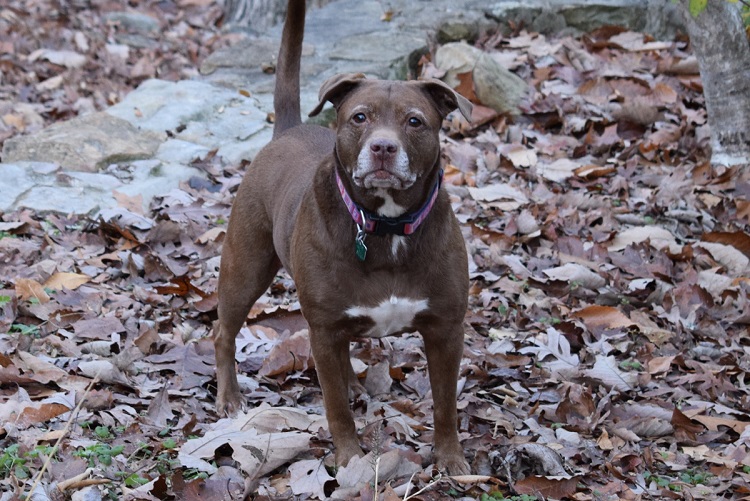
Blue Nose Pitbulls have a short single-layer blue coat but still shed regularly. (All dogs shed.) Some shed more than others, but when they do, it’s typically before Spring and Winter. Pregnancy and hormonal changes can also activate shedding. That said, the Blue Nose Pitbull needs minimal grooming.
Like other dog breeds, to distribute the body’s natural oils evenly, daily brushing in the direction of hair growth will help keep their coats healthy.
Trimming their nails once a month is best to keep them at a comfortable length. A dog’s toenails have blood vessels and nerves, so it’s best to visit your veterinarian for a manicure.
Their ears should be checked regularly, once a week, especially since the ears have traditionally been cropped. A vet will know what to look for in an exam to ensure the health of their ears. Also, keep an eye on their face and eyes to check for any infections, and even gently wipe them down with a wet, warm towel.
Blue Nose Pitbull Health and Care
They are generally healthy dogs, but a Blue Nose Pitbull is more prone to health issues like allergies and skin conditions, so make sure they visit the vet regularly to detect any problems.
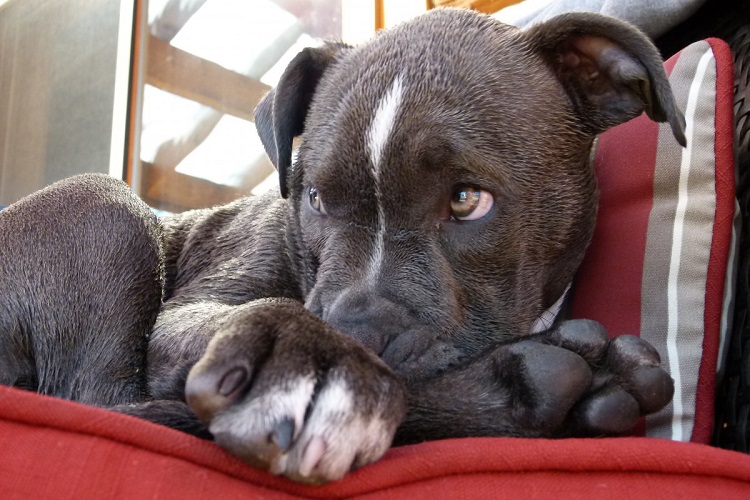
Their immune systems can also be lacking since they’re cross-bred, and quite frankly, you never know what you’ll get since different bully breeds are used.
Here are some other health problems to watch for:
- Knee issues
- Heart disease
- Cataracts
- Hip dysplasia
- Ear infections
- Immune disorders
Make sure to regularly check their body temperature and body weight to notice any changes. If it deviates from the normal range, take your pit bull to the vet immediately.
Things to Consider Before Adopting a Blue Nose Pitbull
The questions that you need to ask yourself before getting a Blue Nose Pitbull puppy are:
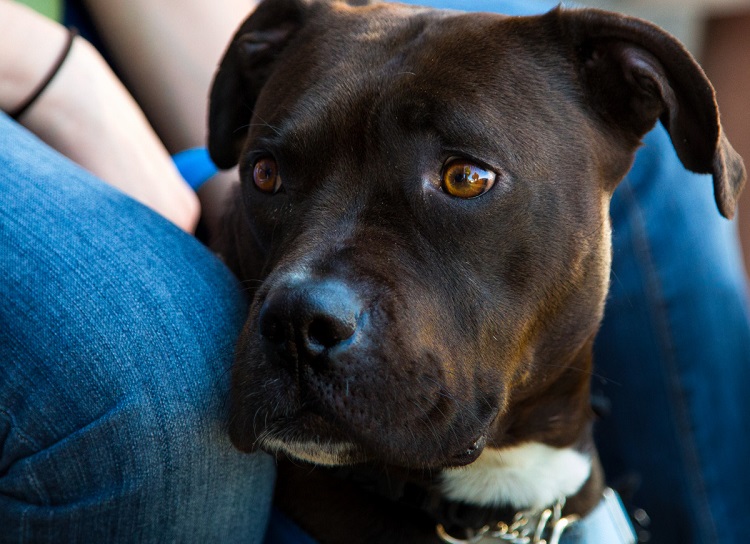
- Do you have a considerable amount of time to give them what they need?
- Do you have other pets in the home? Cats? Birds? Other Dogs?
If you’re adopting a Blue Nose Pitbull puppy, introductions should run fairly smoothly, but as I mentioned before, a professional or someone knowledgeable about introducing animals should be consulted first if you’re adopting an adult dog.
- Do you have the energy and patience to keep up with a Blue Nose Pitbull?
Ideally, you should have an equally active lifestyle as your dog so you can fully enjoy each other.
- Are you experienced with dogs?
This particular dog isn’t a good first choice for someone who hasn’t been around other dogs. Their power alone can overwhelm so they need to be in the hands of someone familiar with dogs. Think “Experienced dog owners only.”
- Have you considered the legal regulations?
There are sometimes policies/rules at apartment buildings, exclusive housing areas/neighborhoods, homeowner’s associations at condominiums, and even cities that charge insurance fees or outright ban any kind of bully breed, including the Blue Nose Pitbull.
Unfortunately, even a dog park can ban them and do. In Iowa, Kansas, and Missouri, hundreds of towns and cities also ban the breed. It’s called BSL (Breed Specific Legislation), and I could write a book on that issue alone.
Blue Nose Pitbull Food and Diet
Like any dog, the diet of a Blue Nose Pitbull is crucial to its physical, mental, and emotional health. And not just what they eat but when and how much.
Frequency of feeding blue nose pitbull puppies:
- Puppies younger than four months: Four meals daily
- Puppies between four and six months: Three meals daily
- Puppies over six months: Two to three meals daily
Always keep your Blue Nose Pitbull puppy on the same food he or she was eating before you brought them home. This will ensure no digestive issues as you ease them into a new diet. In addition, a veterinarian will know your specific dog’s nutritional needs, so consult with him/her well ahead of time.
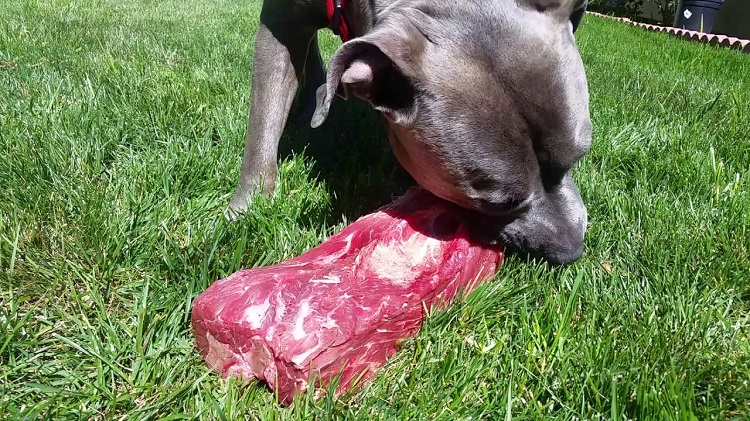
The actual diet is the owner’s preference and can be chosen from these categories:
- Kibble – All-natural brand with premium ingredients (costs a bit more than the average dog food)
- Wet food – Mixed with dry kibble (so as not to upset the stomach as easily)
- BARF (Ha!) (Biologically Appropriate Raw Foods) – If money is no object and you have time to research how your dog will get what he needs nutritionally
Note: As of today, there’s no proof that a raw-food diet is any better or worse than a regular one.
- Homemade – If you’re willing and able to learn from your vet everything your Blue Nose Pitbull needs and from which foods
Giving them a mixture of some or all of the above is often preferable and much more interesting for your dog. You just don’t want to feed them dry kibble one day and wet food the next.
The offerings would be more of a mixture of regular “treats” from a different category. In other words, you could give them a piece of cooked lean meat after they’ve eaten some kibble. If this is your choice, knowing exactly what they need nutritionally is imperative.

If you’re transitioning from one food to another, ease into it. Ask your vet how to do this with ratios and timing. Adult Pit bulls will need a different diet than a puppy, so be sure to stay on top of your dog’s age.
What your dog eats will affect its coat, health, and sometimes even its temperament, so make sure your dog’s getting the vitamins and minerals it needs.
FAQs
What Is the Main Difference Between a Blue Nose Pitbull and a Regular Pitbull?
Since we’ve learned there are no “regular” pitbull, rather, different pitbull breeds, it’s quite difficult to say. It depends on the parents of the Blue Nose and their colorings. However, even with two breeds of Pitbulls, their offspring’s looks and temperament can be a surprise!
How Do You Know If a Pitbull Terrier Is a Blue Nose Pitbull Terrier?
It would be nice to say they’ll have a Blue Nose, but as you’ve learned by now, that’s just not the case. Blue Noses don’t all have blue noses, so it’s really hard to tell unless you’re an expert.
Are Blue-nose Pitbull Terriers More Aggressive than “Regular” Pitbulls?
Their temperaments could be affected if they’re inbred from a closely related dog. Other than that, it’s comparing apples to oranges. There are many things, as we’ve discussed within, that factor into a dog having difficulties with aggression.
Are They Easy to Train?
Some are, and some aren’t. This type of dog is highly intelligent; plus, they love to please humans, so some will catch on quickly. Others, due to inbreeding or other factors, are not. If they’re properly trained, you’ll have a well-behaved dog. As with all dogs, getting a puppy is ideal so you can train them early, and bad habits aren’t learned yet.
How Much Do They Cost?
Expect to pay at least $1,000 for a Blue Nose Pitbull, and the price goes up from there. Backyard breeders generally charge less to make a sale.
Conclusion
By now, you should know just about everything there is to know about the Blue Nose Pitbull. You also know how unique and affectionate they are. So don’t be afraid to choose between having this dog for a best friend.
Sure, it takes a lot of time to learn the ins and outs of ownership, but when you look into your Blue Nose Pitbull’s eyes, it will be worth it.


